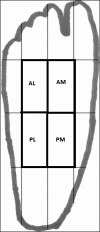Balance training and center-of-pressure location in participants with chronic ankle instability
- PMID: 25562457
- PMCID: PMC4559992
- DOI: 10.4085/1062-6050-49.3.94
Balance training and center-of-pressure location in participants with chronic ankle instability
Abstract
Context: Chronic ankle instability (CAI) occurs in some people after a lateral ankle sprain and often results in residual feelings of instability and episodes of the ankle's giving way. Compared with healthy people, patients with CAI demonstrated poor postural control and used a more anteriorly and laterally positioned center of pressure (COP) during a single-limb static-balance task on a force plate. Balance training is an effective means of altering traditional COP measures; however, whether the overall location of the COP distribution under the foot also changes is unknown.
Objective: To determine if the spatial locations of COP data points in participants with CAI change after a 4-week balance-training program.
Design: Randomized controlled trial.
Setting: Laboratory.
Patients or other participants: Thirty-one persons with self-reported CAI.
Intervention(s): Participants were randomly assigned to a 4-week balance-training program or no balance training.
Main outcome measure(s): We collected a total of 500 COP data points while participants balanced using a single limb on a force plate during a 10-second trial. The location of each COP data point relative to the geometric center of the foot was determined, and the frequency count in 4 sections (anteromedial, anterolateral, posteromedial, posterolateral) was analyzed for differences between groups.
Results: Overall, COP position in the balance-training group shifted from being more anterior to less anterior in both eyes-open trials (before trial = 319.1 ± 165.4, after trial = 160.5 ± 149.5; P = .006) and eyes-closed trials (before trial = 387.9 ± 123.8, after trial = 189.4 ± 102.9; P < .001). The COP for the group that did not perform balance training remained the same in the eyes-open trials (before trial = 214.1 ± 193.3, after trial = 230.0 ± 176.3; P = .54) and eyes-closed trials (before trial = 326.9 ± 134.3, after trial = 338.2 ± 126.1; P = .69).
Conclusions: In participants with CAI, the balance-training program shifted the COP location from anterolateral to posterolateral. The program may have repaired some of the damaged sensorimotor system pathways, resulting in a more optimally functioning and less constrained system.
Keywords: postural control; rehabilitation; sprains.
Figures
References
-
- Waterman BR, Owens BD, Davey S, Zacchilli MA, Belmont PJ., Jr The epidemiology of ankle sprains in the United States. J Bone Joint Surg Am. 2010;92(13):2279–2284. - PubMed
-
- Waterman BR, Belmont PJ, Cameron KL, Deberardino TM, Owens BD. Epidemiology of ankle sprain at the United States Military Academy. Am J Sports Med. 2010;38(4):797–803. - PubMed
-
- Fernandez WG, Yard EE, Comstock RD. Epidemiology of lower extremity injuries among U.S. high school athletes. Acad Emerg Med. 2007;14(7):641–645. - PubMed
-
- van Rijn RM, van Os AG, Bernsen RM, Luijsterburg PA, Koes BW, Bierma-Zeinstra SM. What is the clinical course of acute ankle sprains? A systematic literature review. Am J Med. 2008;121(4):324–331. - PubMed
Publication types
MeSH terms
LinkOut - more resources
Full Text Sources
Other Literature Sources
Medical


